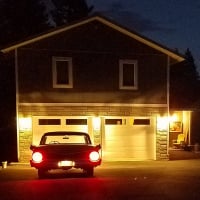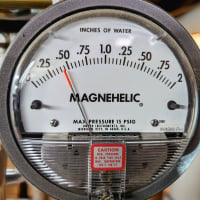Treasures in the Basement of the 1918 Schweser's Dept. Store
Schweser brought the building in 1929 for a high end women's clothing dept store.
They went out of business a few years ago and the building was purchased, thankfully, by a local businessman and his wife. It has been tastefully remodeled into a venue for weddings and other events.
The owner had questions about his steam system so I was of course happy to look.
So often one gets to tour these grand buildings but the basement is off limits to visitors.
Most of my time was spent down there, huge full basement full of interesting items.

This was a postcard photo made as it opened under the original builder/owner.
Built by a German immigrant who did well operating other smaller stores.


But of course the basement:





So a "modern" 1988 PB 211A-05 steamer,
A steam to water heat exchanger, with 2" circulator line.
Then the Arco Wand central vac unit, piped with steel.
The crown jewel, AC compressor unit, water cooled and still in use.
Owner thinks this might be 15 ton, anyone have an idea of tonnage????
Has an almost walk in return plenum, double huge squirrel cage blowers with maybe a 5 HP motor.
The single return air grill is about 5' X 5' at the bottom of the stair case.
The water bill is reasonable as he dumps into storm sewer piping.
He was wondering about replacement when this failed.
I thought water to air HP/AC units. Two sets of twins would give 4 units times 4 tons.
If he used conventional outside units they would have to go on the roof up 3 stories.
Some old Hoffman F&T's, these 2 actually do one return line in and tied together on outlet.

Then some interesting floor tile design;

Remember this is 1918 and the positive rotation of the symbol.
Long before Adolf hijacked and inverted the design.
An ancient Hindu symbol meaning positive energy and good fortune.
I have seen these in Chicago on older buildings and also in India on ancient structures.
And also this was a trademark for, I believe, Crane manufacturing thru the mid 1930's.
Comments
-
What an interesting visit.Bob "hot rod" Rohr
trainer for Caleffi NA
Living the hydronic dream0 -
So, how do they heat the place now? I see some radiators in the basement......All Steamed Up, Inc.
Towson, MD, USA
Steam, Vapor & Hot-Water Heating Specialists
Oil & Gas Burner Service
Consulting0 -
@JUGHNE
Getting the #s off the txv will help with sizing, At 65 amps full load at about 3 amps/horsepower=21 horsepower.
So it's probably abt. a 20 hp motor. 20 horsepower =20 tons when water cooled (if it is air conditioning and not refrigeration)1 -
Those were just stored there.
The steamer is still the main heat source.
I could see very few CI rads up stairs.
There was a long open exposed fin tube that may have been enclosed at one time.
He never commented about any real problems with it, just had some questions.
There was paper cup over the top of the vent on the feeder pump tank though.
It could not have passed much steam as it still looked intact.
To many other things to discuss in the basement to think about heating.
He did not know what the central vac was nor the heat exchanger.
I might visit again in the fall.0 -
ED, he talked of 15 tons of resi units for cooling, perhaps that was what the local HVAC guy was speaking of.
He also has several 3 ton mini's, but they are AC only so may not need the full 20 tons.0 -
Wonderful! Thanks for sharing.Retired and loving it.0
-
Wow! I love that compressor. I agree it would be 20HP and between 15 and 20 tons. How are the 3 ton minis keeping up now?Serving Northern Maine HVAC & Controls. I burn wood, it smells good!0
-
Thank you for sharing the visit and pictures. The building appears to be in prime condition.
We see some of the central vacuum systems installed in older, premium homes in northwest Missouri. Most yet are operable but do not provide the suction todays smaller and portable units do.0 -
I have worked on a old system with the same Westinghouse compressor, it was still working fine when they took the building down to make a parking ramp. System I worked on was gas heat and the AHU had metal plates you slide in and out when switching from heat to A/C. Never had an issue with either the heat or A/C.Old retired Commercial HVAC/R guy in Iowa. Master electrician.0
-
Is that a chiller or does it connect to a DX coil?0
-
@JUGHNE - been in that building many time when I was a kid with Mom and Grandmother (must have been a sale
 ). That building is very cool, but never got past the staff guarding the basement. Across the street and a block west is the Gottberg Auto Co. building from the early 1900s. Sat empty for 40 years before it got it got converted a nice brew pub in the 1990. Always admired the stonework of Ford auto on the building. Never saw the boiler though!
). That building is very cool, but never got past the staff guarding the basement. Across the street and a block west is the Gottberg Auto Co. building from the early 1900s. Sat empty for 40 years before it got it got converted a nice brew pub in the 1990. Always admired the stonework of Ford auto on the building. Never saw the boiler though! 2
2 -
"Dusters" brewery and restaurant.
I just looked down the street at that on Saturday and never noticed the top stonework.
Shows that most people never look at those details.
So much of that old architecture is not noticed nor appreciated.
I have eaten there a few times, the inside is impressive also.
I think there is a boiler in the brewery, you can see the entire processing thru glass windows on the inside.1 -
I only ran into a few of the old Westinghouse units. One was a roof top unit and it had Westinghouse's own hermetic (tin cans) compressors in it.
The other one was a water cooled chiller (two of them in fact) Those had Copeland (tin cans) compressors.
I don't know when Westinghouse stopped making that equipment. I would guess mid-late 60s.
the stuff ran, lasted forever, took a beating and kept running0 -
-
Yea, I’ve eaten in the “silo” brewpub with the view of the tanks several times. Good food but the tractor style seat are really uncomfortable!JUGHNE said:"Dusters" brewery and restaurant. I just looked down the street at that on Saturday and never noticed the top stonework. Shows that most people never look at those details. So much of that old architecture is not noticed nor appreciated. I have eaten there a few times, the inside is impressive also. I think there is a boiler in the brewery, you can see the entire processing thru glass windows on the inside.
The Gottberg mansion was a couple block away from my old house. It was renovated by new owners in early 1990s as well but I’ve noticed it looking a bit careworn these days. Don’t think the modern 1990 painted white wood is holding up too well to the Nebraska weather. Time to break out the Azek PVC ! 0
! 0 -
My friends have a house in detroit that has a similar carrier condenser. It wasn't clear with that if it was DX or chilling water but i'm pretty sure that is also DX if that one is. Th had a tag on it saying it was pumped down in like the mid 60's.0
-
I was in a basement of a not extremely large house here in St. Louis this past winter and it had retained its original Arco Wand central vacuum system similar to that in the photo above. I've never seen one before myself. The homeowner said it was working until just a few years ago and that it sounded like a jet engine spooling up when it started. Same situation as you noted, piped with massive metal pipes. Amazing.
You see that reverse-of-swastika pattern all over Japan, as there it means good luck. Interestingly, a house down the street from me here has the same tile design on their front porch floor.
0 -
I believe that compressor is 20-22 ton. They pretty much lasted forever. National Rebuilders in Queens would probably know for sure0
-
What a beautiful old building! So great to see equipment of that age still in working condition. I notice elevator controls beside the staircase -- would have been constant-pressure or possibly attendant-operated originally but looks like it's been modernized. My own 25-unit 4-storey apartment building (constructed in 4 months in the summer of 1925!) has two Otis-Fensom lifts, with hinged doors, Bostwick gates, and the original constant-pressure controls, all in good working order. Our tech told me there's an identical unit in the Smithsonian, so ours are legitimately museum pieces :-) (To stay on topic, we're heated by an oversized Weil-McLain 1280 steamer, with a backup 978. When I moved in in 2006, the system had been badly neglected and was operated by the super's husband -- a wind-tunnel engineer -- who ran it at 7-9 psig. When I got elected to the Board, I brought a good contractor in. After repairing 60% of the rad traps and 100% of the F&Ts, adding a Tekmar outdoor reset and steam-established sensor, we got it all running beautifully at 1-2 psig. And people closed their windows in winter ;-)
Here's our guy, Aron Butts, giving a tour: https://www.facebook.com/cordellmechanical/videos/557469135332718
PS: I say "oversized" because the engineers who spec'd the 1280 did a heat-loss study instead of a radiator inventory. They should have read Dan's book! At least 1/3 of the original cast-iron rads had been removed. On the coldest day of the year, at minimum flame, the 1280 still shuts down on pressure every 10 minutes or so.)Resident in 25-unit co-op, Toronto, built in 1925. In self-defence,"expert" on our 2-pipe steam system.
0 -
PS: the gas budget went from $40,000/yr to $18,000/yr (and that includes DHW and 3 well-used laundry dryers).
Resident in 25-unit co-op, Toronto, built in 1925. In self-defence,"expert" on our 2-pipe steam system.
0 -
-
Stuart, good eye for the elevator controls. Your building looks equally impressive also.
There is a power unit in the basement, hydraulic piston system.
There is a control panel about 5' x 5' with what looked to be 50 plus electro mechanical relays in it.
This building has 3 floors but is joined to the building in the left of the picture.
So the floor elevations do not match, I think the cars are double doors to achieve the miss-match.
As far as the vacuum pump, it could have been a pneumatic system, IDK.
My wife used to visit the store and asked if there was some such system.
Maybe PC recalls as he visited the place also.
We had a very small mercantile store here that had a "trolley car" system on a cable that would send the money up to the 2nd floor office of the manager.
There was no cash on the main store floor.
It would go up with the money and receipt and return with the cash/coin change and the receipt marked paid.
I don't know how it was powered...some form of wind up spring??0 -
Nice to see Mechanical history in action.
I saw a vacuum cleaning system in a 19th century mansion located in Manchester, NH with a Roots Blower on it. It looks like it had been idle for years. These were designed for blast furnaces in around 1860 by the Roots Brothers of Indiana.
They have been used on internal combustion engines to increase power, with some ill effects until better understood. They're also used on septic tank and catch basin vacuum pumps in modern day.
Cool stuff.0 -
Many years ago (1980-81), when living in the D.C. area, I worked on an a/c system dating from the 1930s which featured a Westinghouse semi-hermetic from that era. It was a R-12 system, direct expansion, my recollection was 15-ton. Compressor rpms? 850! No surprise it lasted as long as it did; for all I know it might still be running. (The GE "Monitor Top" home fridge compressors from the 19-teens and 20's ran at 1140 rpm-not uncommon to find those still running, too).0
-
The Gottberg Auto building is almost a copy of a dealership built in my home town. Even down to the brick matching brick. Just does not have the fancy stonework on top.....I can't remember what make was sold in the building. Wonder if this design was a standard for one of the car manufacturers?0
-
This was a Ford dealership, IIUC.0
-
Another Roots blower application that many of us don't know about- the Federal Thunderbolt siren:Kickstand55 said:Nice to see Mechanical history in action.
I saw a vacuum cleaning system in a 19th century mansion located in Manchester, NH with a Roots Blower on it. It looks like it had been idle for years. These were designed for blast furnaces in around 1860 by the Roots Brothers of Indiana.
They have been used on internal combustion engines to increase power, with some ill effects until better understood. They're also used on septic tank and catch basin vacuum pumps in modern day.
Cool stuff. https://www.youtube.com/watch?v=LriueIPl-JA
https://www.youtube.com/watch?v=LriueIPl-JA
On this one, the box with the blower is mounted a bit more than halfway up the pole. The rotator is in the box just below the horn, and the chopper (which produces the sound) is right at the base of the horn and has its own motor. This makes the production of sound independent of the blower speed.
These things are LOUD!All Steamed Up, Inc.
Towson, MD, USA
Steam, Vapor & Hot-Water Heating Specialists
Oil & Gas Burner Service
Consulting2 -
-
I don’t recall any pneumatic tube systems, just a lot of those old half body mannequins. 😝.JUGHNE said:Stuart, good eye for the elevator controls. Your building looks equally impressive also. There is a power unit in the basement, hydraulic piston system. There is a control panel about 5' x 5' with what looked to be 50 plus electro mechanical relays in it. This building has 3 floors but is joined to the building in the left of the picture. So the floor elevations do not match, I think the cars are double doors to achieve the miss-match. As far as the vacuum pump, it could have been a pneumatic system, IDK. My wife used to visit the store and asked if there was some such system. Maybe PC recalls as he visited the place also?There have been a lot of those old building sitting empty beginning in the 1970’s when stores all moved out to Hwy 31 / 23rd street. Kmart, Tempo, Alco were first of the big box stores in town to pop up there and JCPenney’s and Sears soon moved too. All gone now, replaced by Walmart, Target and Menards. The local Meads lumber is still going strong, they also moved out of downtown.0 -
@ChrisJ has a monitor top and ball top in his kitchen right now, still going strong.OuterCapeOilguy said:Many years ago (1980-81), when living in the D.C. area, I worked on an a/c system dating from the 1930s which featured a Westinghouse semi-hermetic from that era. It was a R-12 system, direct expansion, my recollection was 15-ton. Compressor rpms? 850! No surprise it lasted as long as it did; for all I know it might still be running. (The GE "Monitor Top" home fridge compressors from the 19-teens and 20's ran at 1140 rpm-not uncommon to find those still running, too).1 -
The monitor tops were 1927-1938 and ran 1750 rpm.
Single pipe 392sqft system with an EG-40 rated for 325sqft and it's silent and balanced at all times.
0 -
Sure love these old pics, thanks! And guessing by the amperage draw on the compressor, it is a 20 ton unit. So if the envelope has been improved (better windows, insulation) your 4x4 HP recommendation is right on. Although I love the idea of steam and its fabulous heat transfer ability, I love the idea of sustainable design even more.1
-
Categories
- All Categories
- 87.2K THE MAIN WALL
- 3.2K A-C, Heat Pumps & Refrigeration
- 60 Biomass
- 427 Carbon Monoxide Awareness
- 118 Chimneys & Flues
- 2.1K Domestic Hot Water
- 5.8K Gas Heating
- 113 Geothermal
- 164 Indoor-Air Quality
- 3.7K Oil Heating
- 73 Pipe Deterioration
- 1K Plumbing
- 6.4K Radiant Heating
- 393 Solar
- 15.5K Strictly Steam
- 3.4K Thermostats and Controls
- 56 Water Quality
- 51 Industry Classes
- 49 Job Opportunities
- 18 Recall Announcements








